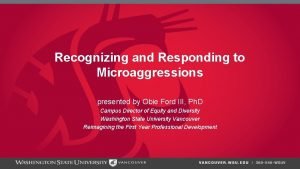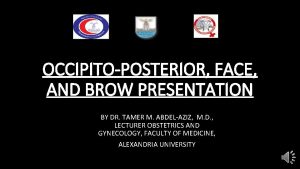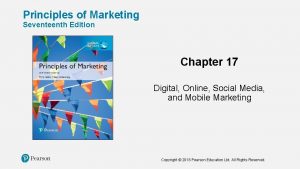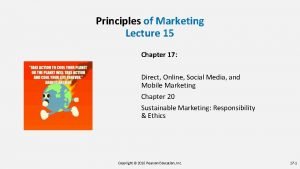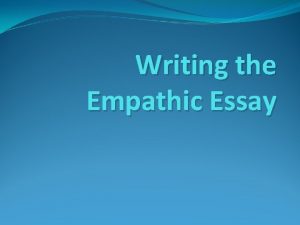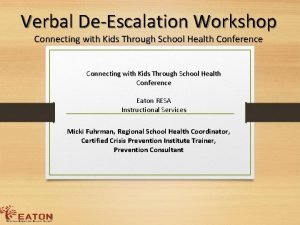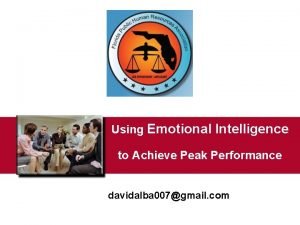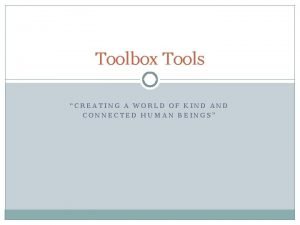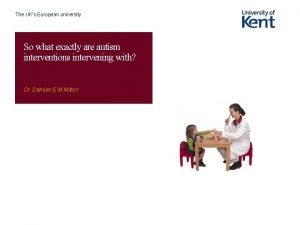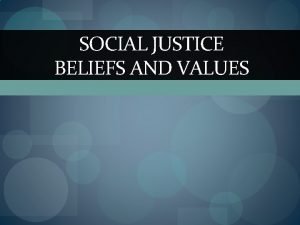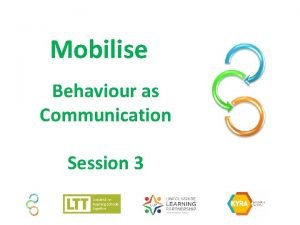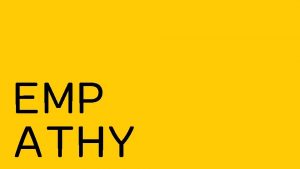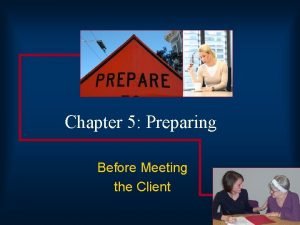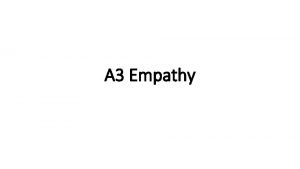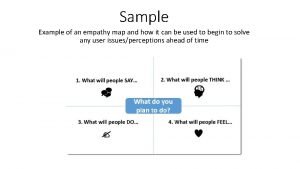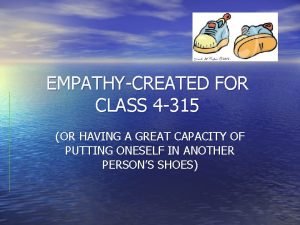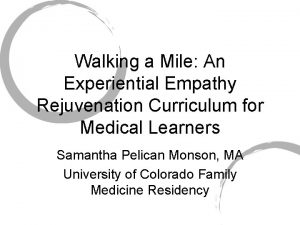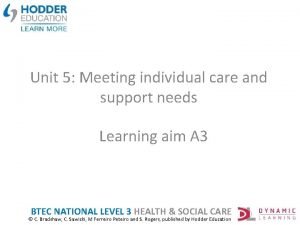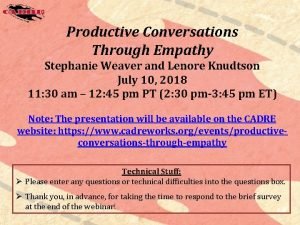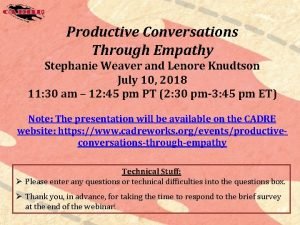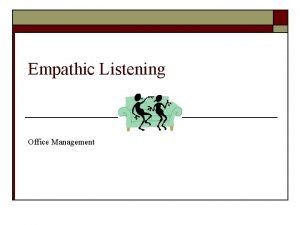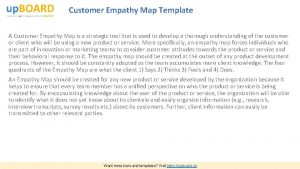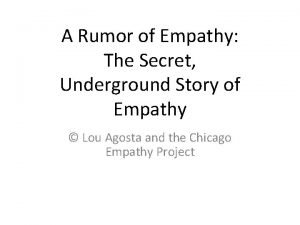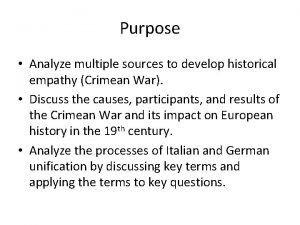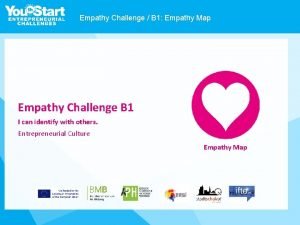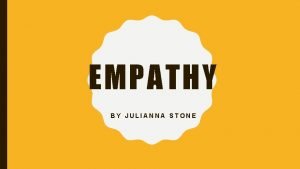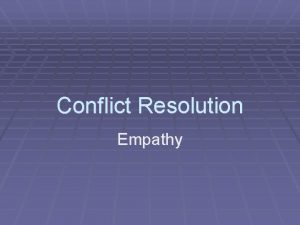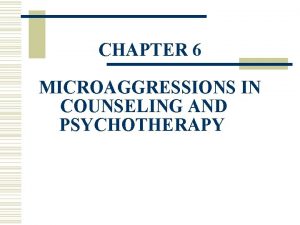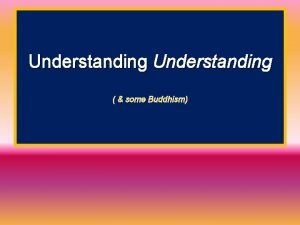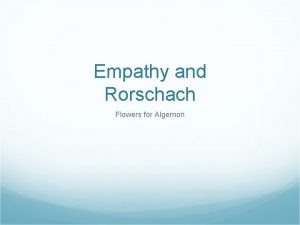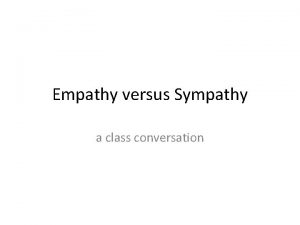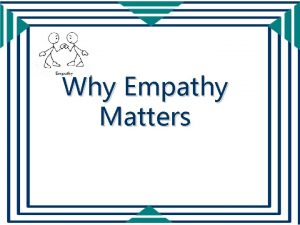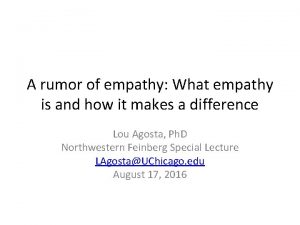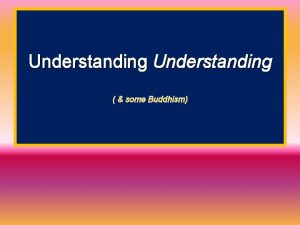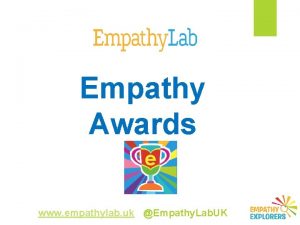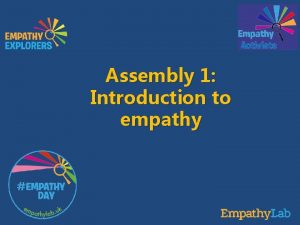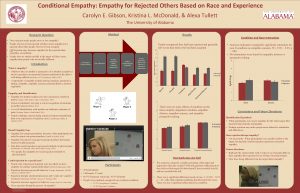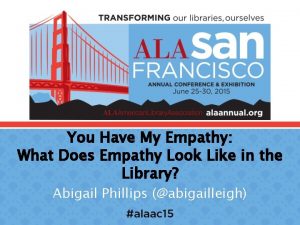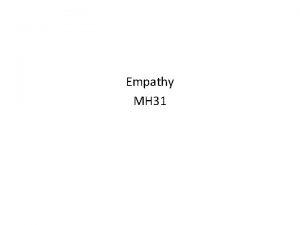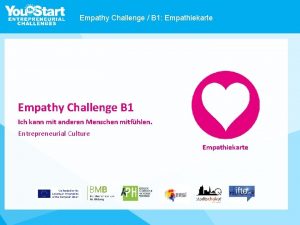Microaggressions in a Time of Trauma Engaging Empathy




























![Vicarious Trauma “an event that “bring[s] up an array of painful memories. . . Vicarious Trauma “an event that “bring[s] up an array of painful memories. . .](https://slidetodoc.com/presentation_image_h/20671303dc4806b4039d822f648e4fcb/image-29.jpg)









- Slides: 38

Microaggressions in a Time of Trauma: Engaging Empathy with Colleagues as a Form of Antiracism ALAO Annual Conference, Virtual 2020 Chris Robinson-Nkongola and Edith Scarletto Reference & Instruction Librarians Jerome Library Bowling Green State University Bowling Green, OH

Introduction Ø Trauma Ø COVID 19 Ø The killing of Black people by police during COVID 19 Ø Racial Microaggressions Ø Definition

Microaggressions in a Time of Trauma: Engaging Empathy with Colleagues as a Form of Antiracism Racial Microaggressions Defined

COVID 19 by Race and Ethnicity Race and ethnicity are risk markers for other underlying conditions that impact health — including socioeconomic status, access to health care, and increased exposure to the virus due to occupation (e. g. , frontline, essential, and critical infrastructure workers).

Killing of Black People during COVID 19 Ø Ahmaud Arbery- 02/23/20 Ø Breonna Taylor-03/13/20 Ø George Floyd- 05/25/20

What are Racial Microaggressions? “The power of racial microaggressions lies in their invisibility to the perpetrator and the recipient”. Sue, D. W. , Capodilupo, C. M. , Torino, G. C. , Bucceri, J. M. , Holder, A. M. B. , Nadal, K. L. , & Esquilin, M. (2007). Racial microaggressions in everyday life. The American Psychologist, 62(4), 271286. doi: 10. 1037/0003 -066 X. 62. 4. 271 • Are brief and commonplace daily verbal, behavioral and environmental indignities, whether intentional or unintentional, that communicate hostile, derogatory, or negative racial slights and insults to the target person or group. • Racial microaggressions can be environmental where a BIPOC is unintentionally exposed to an office environment that assails their racial identity. • According to Derald Wing Sue, et. al "Almost all inter-racial encounters are prone to microaggressions. "

Taxonomy of Microaggressions Ø Microassaults Ø Microinsults Ø Microinvalidations

Microassaults Ø Conscious and deliberate Ø Referred to as “old fashion racism”. Ø Call someone the N-word Ø Refusing to serve a POC Ø Displaying the hood of the Ku Klux Klan Ø Displaying the Confederate Battle Flag

The most recent and well-known microassualts

Themes within the attitudes and behaviors of Microaggressions • • • Microinsults Alien in One’s Own Land Second-class status Ascription of Intelligence Assumption of Criminality Pathologizing cultural values and styles • • • Microinvalidations Myth of Meritocracy Environmental Invalidation Denial of individual racism Color blindness

BIPOC are not Crazy or Too Sensitive • Empirical Evidence proves that Racial Microaggressions exist • Mercer, Sterett H. , et. al (2011). Development and Initial Validation of the Inventory of Microaggressions Against Black Individuals. Journal of Counseling Psychology, 58, 4. • Nadal, Kevin L. (2011). “The Racial and Ethnic Microaggressions Scale (REMS): Construction, Reliability, and Validity”. Journal of Counseling Psychology, 58, 4. • Sue, Derald Wing, Capodilupo, Christina, Holder, Aisha M. B. (2008). “Racial Microaggressions in the Life Experience of Black Americans. Professionals Psychology : Research and Practice, 39, 3 • Sue, Derald Wing, et. al (2007). “Racial Microaggressions in Everyday Life: Implications for Clinical Practice. American Psychological Association, 62, 4.

The Effects of Microaggressions • Depression • Poor performance at work and school • Isolation • Low self-esteem • Feeling of Powerlessness • Self-doubt • Racial rage • Racial Battle Fatigue • Keeps White people from seeing a different racial reality and participating in establishing racial harmony

References • Arnold, N. W. , Crawford, E. R. , & Khalifa, M. (2016). Psychological Heuristics and Faculty of Color: Racial Battle Fatigue and Tenure/Promotion. The Journal of Higher Education, 87(6), 890 -919. doi: 10. 1353/jhe. 2016. 0033 • Blitt, B. (2018, July 21). The New Yorker July 21, 2008 Issue. Retrieved April 23, 2019, from https: //www. newyorker. com/magazine/2008/07/21 • Cavna, M. (2018, September 12). An Australian artist's racist Serena Williams cartoon receives swift and international blowback. Retrieved April 23, 2019, from https: //www. washingtonpost. com/news/comic-riffs/wp/2018/09/10/an-australian-artists-racistserena-williams-cartoon-receives-swift-and-international-blowback/ • Pilgrim, D. (2000, October). The Picaninny Caricature. Retrieved April 24, 2019, from https: //www. ferris. edu/HTMLS/news/jimcrow/antiblack/picaninny/homepage. htm

Further Reading • Drake, H. (2019, April 17). Working 9 -to-5 In White Spaces. Retrieved April 24, 2019, from https: //www. leoweekly. com/2019/04/working-9 -5 -white -spaces/ • Pizarro, M. , & Kohli, R. (2018). “I Stopped Sleeping”: Teachers of Color and the Impact of Racial Battle Fatigue. Urban Education, 004208591880578. doi: 10. 1177/0042085918805788 • Sandhu, S. , & Sandhu, S. (2018, September 19). Why the Serena Williams US Open cartoon actually is racist. Retrieved October 03, 2020 from https: //inews. co. uk/sport/tennis/serena-williams-cartoon-why-racist-herald-sun-caricature/ • Smith, W. A. , Yosso, T. J. , & Solorzano, D. G. (n. d. ). Challenging racial battle fatigue on historically white campuses: A critical race examination of race-related stress. In Faculty of Color: Teaching in predominately white colleges and universities (pp. 299 -327). Bolton, MA: Anker Publishing. • Smith, W. A. , Yosso, T. J. , & Solórzano, D. G. (2007). Racial Primes and Black Misandry on Historically White Campuses: Toward Critical Race Accountability in Educational Administration Quarterly, 43(5), 559 -585. doi: 10. 1177/0013161 x 07307793 • Sue, D. W. , Capodilupo, C. M. , Torino, G. C. , Bucceri, J. M. , Holder, A. M. B. , Nadal, K. L. , & Esquilin, M. (2007). Racial microaggressions in everyday life. The American Psychologist, 62(4), 271 -286. doi: 10. 1037/0003 -066 X. 62. 4. 271 • Swayne, M. , & Messer, A. (2011, March 11). Discrimination creates racial battle fatigue for African-Americans. Retrieved October 3, 2020 from https: //news. psu. edu/story/160177/2011/03/11/campus-life/discrimination-creates-racial-battle-fatigue-african-americans

Engaging Empathy using Nine Why’s ALAO Annual Conference, Virtual 2020 Chris Robinson-Nkongola and Edith Scarletto Reference & Instruction Librarians Jerome Library Bowling Green State University Bowling Green, OH

Part II: An interactive reflective exercise Reflective document for use during this part of the presentation (anonymously) https: //forms. gle/HT 6 ZA 89 Hku. Bfoxni 9 View and reflect on the answers of your colleagues https: //bit. ly/30 G 4 UZ 9

What is empathy? noun the psychological identification with or vicarious experiencing of the feelings, thoughts, or attitudes of another. the imaginative ascribing to an object, as a natural object or work of art, feelings or attitudes present in oneself: By means of empathy, a great painting becomes a mirror of the self. Dictionary. com, noun

Why is empathy important in the workplace? • Our workplaces mirror our world • Situations in the world affect our colleagues • Pandemics and protests in our world can mirror and exacerbate the conflicts/inequality in our workplaces Gibson, A. , Chancellor, R. , Cooke, N. , Dahlen, S. , Patin, B. , & Shorish, Y. (2020). Struggling to Breathe: COVID-19, Protest, and the LIS Response.

How might personal events affect you at work? • • • Stress of being a caregiver for a loved one Family or loved one who passed Financial difficulty Moving, you or a family member Relationship difficulties Unrest or unease within your organization *Use the reflection form to reflect on these events in your own life

Consider some world and national events • • • September 11 th Hurricane Katrina/ Florence Iowa/ Maryland Flooding California wildfires/Mudslides Space Shuttle disasters Virginia Tech/Pulse Night Club/Church shootings *Use the reflection form to reflect on these events in your own life

What kinds of empathy can we express? • ‘affective’ component – vicariously taking on others’ feelings • ‘cognitive’ component – reasoning about others’ emotions • ‘motivational’ component – desiring for others’ emotional states to improve Zaki, J. (2016; 2017; ). Moving beyond stereotypes of empathy. Trends in Cognitive Sciences, 21(2), p. 59. doi: 10. 1016/j. tics. 2016. 12. 004

How has the pandemic affected us? • Know or be someone who has been sick? • Know someone who is extremely vulnerable to illness • Know someone who lives with someone who is vulnerable *Use the reflection form to reflect on these events in your own life

We can’t know everything about our colleagues We can be aware of events around us and reason, or express cognitive empathy The events of the pandemic give us many opportunities for empathy

While situations affect us differently consider the ways colleagues may be affected. Know or be someone who has been sick Know someone who is extremely vulnerable to illness Know someone who lives with someone who is vulnerable

Now let’s talk about race and antiracism Just like natural disasters, race relations and racist events affect us and our colleagues differently Colleagues who are black or people of color may experience these events more intensely than white colleagues

George Floyd, Ahmaud Arbery, Breonna Taylor & Covid-19 You may not have experienced some of the world events mentioned earlier. You may not have experienced racial microaggressions before You may not be vulnerable to Covid-19

Empathy does not require experience You can understand that stress from world events may cause stress to your colleagues who are more connected to the event. You can understand that black folks and people of color are disproportionally dying or becoming ill from Covid-19 You can understand that many things happen to our colleagues we do not know, but you can still extend empathy.

Historical Trauma • Just as you can empathize with trauma that is not your own • You can experience trauma by frequent reminders of triggering events
![Vicarious Trauma an event that brings up an array of painful memories Vicarious Trauma “an event that “bring[s] up an array of painful memories. . .](https://slidetodoc.com/presentation_image_h/20671303dc4806b4039d822f648e4fcb/image-29.jpg)
Vicarious Trauma “an event that “bring[s] up an array of painful memories. . . it can trigger vicarious traumatization. Even if the specific event has never happened to us directly, we may have witnessed similar experiences, or know people in our communities who have been traumatized or killed in similar ways. ” Kendall, M. (2020). Hood feminism: Notes from the women a movement forgot. New York: Viking.

Empathy as a form of antiracism • Just as you can empathize with trauma that is not your own natural disasters and world events • You can empathize with folks who experience trauma by frequent reminders of triggering events repeated acts of violence against people of color

Antiracism • Be aware of your workplace and how it appears to colleagues who may be experiencing the trauma of the pandemic and/or racist violence in the news • Be aware of and envoke emapthy for, microaggressions as they happen. • Rehearse responding to microaggressions

Antiracism "An antiracist is someone who is supporting an antiracist policy by their actions or expressing an antiracist idea. “Racist” and “antiracist” are like peelable name tags that are placed and replaced based on what someone is doing or not doing, supporting or expressing in each moment. These are not permanent tattoos" Kendi, I. X. (2019). How to be an antiracist. Pro. Quest Ebook Central https: //ebookcentral-proquest-com. ezproxy. bgsu. edu

Antiracism To do antiracist work is to continue to act against structures and actions that reduce our empathy for our colleagues. It means constantly decentering white experience as the norm of the world and the workplace It means making mistakes, recognizing those mistakes and acting to change them It means extending emapthy to black colleagues and colleagues of color in work situations as well as personal.

What do empathy and microaggressions have in common? Fiske's Core Social Motives To belong to a group To understand the world around us To control what we can To trust in the group To self enhance (self worth) Have, S. , Rijsman, J. , Have, W. , & Westhof, J. (2018). The social psychology of change management (1 st ed. ) Routledge.

Confronting microagressions When we feel defensive, we feel that one of our social motives has been challenged. Empathizing with a colleague can help address the issue that prompted a microaggress

How can empathy about a social motive help? What has challenged the person speaking rudely? What can the receiver say to address that concern or assumption? *Use the reflection form to reflect on these events in your own life

Summary • Using emapthy to understand trauma can help us to care for our colleagues in a time of crisis • Racism and racial trauma can be experienced through vicarious and historical triggers • Decentering the white experience and acknowledging the experience of colleagues through empathy can become antiracist act • Empathy can also be a tool to confront microaggressions and racism in the workplace by applying to social motives

References Gibson, A. , Chancellor, R. , Cooke, N. , Dahlen, S. , Patin, B. , & Shorish, Y. (2020). Struggling to Breathe: COVID-19, Protest, and the LIS Response. https: //scholarcommons. sc. edu/libsci_facpub/291/ Have, S. , Rijsman, J. , Have, W. , & Westhof, J. (2018). The social psychology of change management (1 st ed. ) Routledge. Kendall, M. (2020). Hood feminism: Notes from the women a movement forgot. New York: Viking. Kendi, I. X. (2019). How to be an antiracist. Pro. Quest Ebook Central https: //ebookcentral-proquestcom. ezproxy. bgsu. edu. New York: One World. Wesley-Esquimaux, C. C. & Smolewski, M. (2004). Historic trauma and aboriginal healing. Aboriginal Healing Foundation (AHF). http: //www. ahf. ca/downloads/historic-trauma. pdf. Zaki, J. (2016; 2017; ). Moving beyond stereotypes of empathy. Trends in Cognitive Sciences, 21(2), p. 59. doi: 10. 1016/j. tics. 2016. 12. 004
 Microaggressions in relationships
Microaggressions in relationships Obie ford iii
Obie ford iii Microaggressions
Microaggressions Occipito-posterior
Occipito-posterior Engaging dynamics
Engaging dynamics Marketing involve engaging directly with carefully targeted
Marketing involve engaging directly with carefully targeted Marketing involve engaging directly with carefully targeted
Marketing involve engaging directly with carefully targeted Start time end time and elapsed time
Start time end time and elapsed time Writing an essay
Writing an essay Levels of empathy
Levels of empathy Brene brown empathy video
Brene brown empathy video Components of empathy
Components of empathy Quiet safe place tool
Quiet safe place tool Double empathy problem
Double empathy problem Power of empathy brene brown
Power of empathy brene brown Hot cold empathy gap
Hot cold empathy gap Brene brown empathy video
Brene brown empathy video Empathy theories johannes volkelt
Empathy theories johannes volkelt Essential questions about empathy
Essential questions about empathy Empathy misses
Empathy misses Preparatory exploring social work
Preparatory exploring social work Double empathy problem
Double empathy problem Attachment and emotional resilience theory
Attachment and emotional resilience theory Ear empathy attention respect
Ear empathy attention respect Empathy map example
Empathy map example Jackie robinson empathy
Jackie robinson empathy Empathy blockers
Empathy blockers Empathy is an interpersonal skill
Empathy is an interpersonal skill Experiential empathy
Experiential empathy Martin hoffman empathy theory health and social care
Martin hoffman empathy theory health and social care Theme paragraph example
Theme paragraph example Lego serious play design thinking
Lego serious play design thinking Productive conversations take real empathy
Productive conversations take real empathy Productive conversations take real empathy
Productive conversations take real empathy Empathy in friendships
Empathy in friendships Empathetic listening
Empathetic listening Customer empathy map template
Customer empathy map template How empathy works
How empathy works Historical empathy definition
Historical empathy definition

